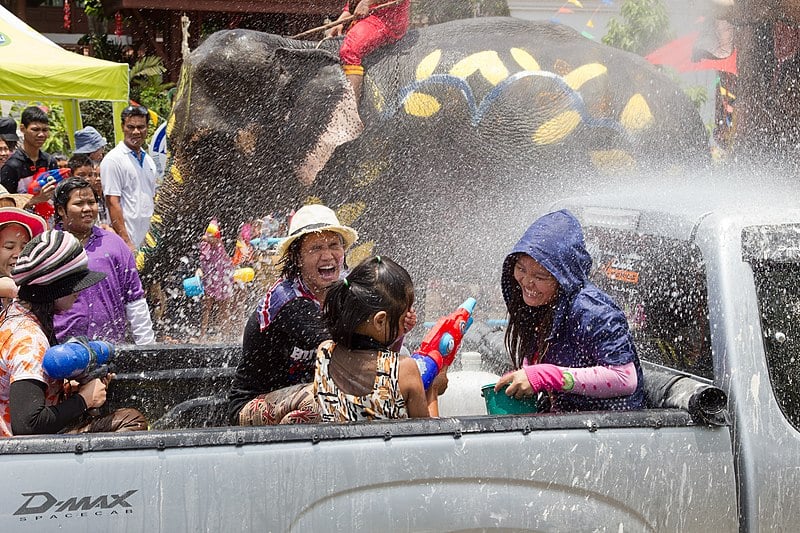
Water gun-toting foreign and local tourists had the time of their lives in Thailand’s three-day Songkran holiday, which was celebrated at full blast for the first time since 2019, significantly boosting local businesses and economies in a country still reeling from the effects of the COVID-19 pandemic.
Thailand’s Songkran celebrations last April 13 to 15 marked a milestone in the Southeast Asian country’s tourism sector and economy in general, as cities resumed activities involving mainly large-scale water fights for the first time in four years. Almost 200 official locations across the capital celebrated Songkran, and in the Gulf of Thailand, island-wide water fights were held, where people from all walks of life, including tourists from all over the world, brought out every fun aspect of Thailand.
The celebrations came a long way from ancient traditions that featured homecomings and family reunions, Buddhist rituals, and water-splashing parties. Starting out as a religious festival, Songkran gradually evolved into Thailand’s biggest and most exciting holiday. The traditional sprinkling of water on the hands of elders to mark the new year turned into huge water fights that became the festival’s main draw for tourists around the world. This water-splashing tradition took hold since Songkran is celebrated at just the right time, during April, the hottest month in Thailand, and the month usually reserved for summer vacations. The hedonistic celebrations would draw thousands of local and foreign tourists, providing an annual boost in travel, accommodation, and consumption. More recently, thousands of locals and tourists alike would gather and form impromptu armies of intoxicated water gun soldiers.
In the years during and right after the peak of the pandemic, public celebrations were banned or discouraged to curb the spread of the virus, and this affected tourism and other related industries. Street vendors, including the water gun sellers, were the hardest hit. The restrictions lasted until last year when the water fights were officially banned on Khao San Road, a party area that’s very popular among foreign tourists.
According to government data, Thailand received more than six million tourists in the first quarter of 2023, with at least 30 million expected to visit throughout the year, with spending amounting to 1.5 trillion THB, or 44 billion USD. As travelers are now able to go to Thailand, the key tourism sector was seen as able to help revive Southeast Asia’s second-largest economy, which has bounced back slower from the pandemic than other countries in Southeast Asia, with growth by as much as 4 percent this year, the fastest rate in five years. This was already a good sign that the Songkran celebrations would resume this year.
It was initially estimated that the Songkran festivities will bring in roughly 125 billion THB, or 3.5 billion USD, according to the University of the Thai Chamber of Commerce. Airbnb affirmed a renewed vigor among celebrants, as the number of tourists searching for accommodations during the holiday period has jumped by 310% this year. Airbnb also mentioned that Thailand remained the platform’s top destination among foreign tourists, especially during Songkran.
This year, things have dramatically gone for the better, as the Tourism Authority of Thailand (TAT) and provincial authorities across the country have planned big water wars and entertainment events for the first time in four years. According to Thai Hotel Association president Marisa Sukosol Nunbhakdi the tourism sector was picking up faster than expected, stating that there was “definitely pent-up demand for travel within Asia.” In Bangkok alone, there were 40 designated spots for water splashing, including the aforementioned Khao San Road, where vendors sold food, clothes, and water guns. Celebrations were held even in Chiang Mai, which recently had high levels of air pollution that have persisted in the northern part of Thailand for months. Like in the previous Songkran celebrations, the water fights remain unabated. Tourists were warned to leave electronic gadgets like mobile phones and cameras at home, and people were also encouraged to avoid driving through busy thoroughfares.
When the celebrations concluded, the TAT estimated that this year’s Songkran has seen about 18 billion THB, or 530 million USD, in spending by revelers across the country, a 525 percent increase over the same period in 2022, but still 58% from 2019’s number. The organization also estimated that total tourism revenues for 2023 will reach about 2.38 trillion THB, including 1.3 trillion THB from more than 30 million foreign tourists and around 800 million THB from local tourists. With Songkran celebrations officially back in Thailand, the public and private sectors of the country are confident that tourism will eventually regain its footing.
Want to know more interesting Asian insights? Check out our other Eye on Asia articles like the emerging post-pandemic trends in the Asia Pacific region, and the Gen Z's consumption of Korean content and products across Southeast Asia.

 Download Panel Book
Download Panel Book


